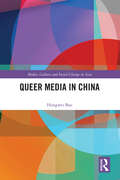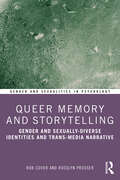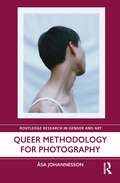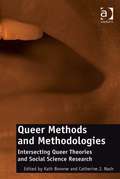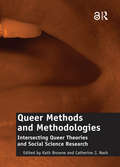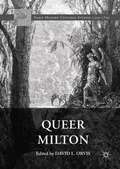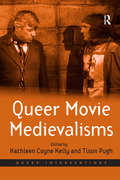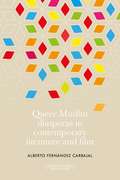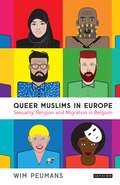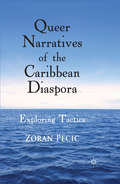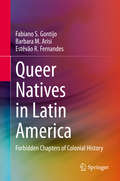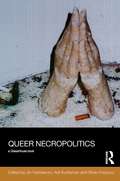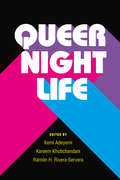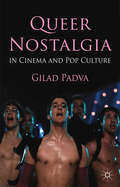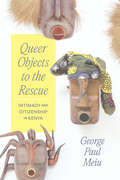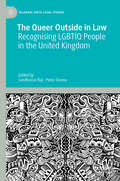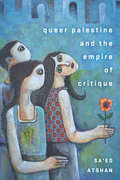- Table View
- List View
Queer Media in China (Media, Culture and Social Change in Asia)
by Hongwei BaoThis book examines different forms and practices of queer media, that is, the films, websites, zines, and film festivals produced by, for, and about lesbian, gay, bisexual, transgender, and queer (LGBTQ) people in China in the first two decades of the twenty-first century. It traces how queer communities have emerged in urban China and identifies the pivotal role that community media have played in the process. It also explores how these media shape community cultures and perform the role of social and cultural activism in a country where queer identities have only recently emerged and explicit forms of social activism are under serious political constraints. Importantly, because queer media is ‘niche’ and ‘narrowcasting’ rather than ‘broadcasting’ and ‘mass communication,’ the subject compels a rethinking of some often-taken-for-granted assumptions about how media relates to the state, the market, and individuals. Overall, the book reveals a great deal about queer communities and identities, queer activism, and about media and social and political attitudes in China.
Queer Media in China (Media, Culture and Social Change in Asia)
by Hongwei BaoThis book examines different forms and practices of queer media, that is, the films, websites, zines, and film festivals produced by, for, and about lesbian, gay, bisexual, transgender, and queer (LGBTQ) people in China in the first two decades of the twenty-first century. It traces how queer communities have emerged in urban China and identifies the pivotal role that community media have played in the process. It also explores how these media shape community cultures and perform the role of social and cultural activism in a country where queer identities have only recently emerged and explicit forms of social activism are under serious political constraints. Importantly, because queer media is ‘niche’ and ‘narrowcasting’ rather than ‘broadcasting’ and ‘mass communication,’ the subject compels a rethinking of some often-taken-for-granted assumptions about how media relates to the state, the market, and individuals. Overall, the book reveals a great deal about queer communities and identities, queer activism, and about media and social and political attitudes in China.
Queer Memory and Storytelling: Gender and Sexually-Diverse Identities and Trans-Media Narrative (Gender and Sexualities in Psychology)
by Rob Cover Rosslyn ProsserQueer Memory and Storytelling unpacks the ways in which the narrative practices of recounting past experiences play a formative role in formation of identities, cultures, and social change among gender and sexually diverse individuals.Grounded in theoretical research, this work delves into historical accounts, case studies, and draws from the rich tapestry of interviews conducted during extensive LGBTQ+ research studies. It explores the power of memorial storytelling to shape the narratives surrounding gender and sexual diversity, offering profound insights into the role storytelling plays as a deeply subjective, personal, communal, and cultural form of expression. The book introduces a queer perspective that reframes the study of narrative psychology, community history, philosophies of subjectivity and the socio-cultural heritage of LGBTQ+ minority communities. It also focuses on the pivotal role played by memory and reflection found within online coming-up stories and contemporary modes of shared community memorialization. By employing queer theory, ethnographic research, interviews and meticulous media/textual analysis, the book presents new frameworks for comprehending the myriad facets of identity, and investigating what it means to remember and narrate selfhood in the context of social life, actively ‘queering’ the concept of memory.Queer Memory and Storytelling will appeal to academics, researchers and students in psychology, sociology, gender and sexuality studies, and communication.
Queer Memory and Storytelling: Gender and Sexually-Diverse Identities and Trans-Media Narrative (Gender and Sexualities in Psychology)
by Rob Cover Rosslyn ProsserQueer Memory and Storytelling unpacks the ways in which the narrative practices of recounting past experiences play a formative role in formation of identities, cultures, and social change among gender and sexually diverse individuals.Grounded in theoretical research, this work delves into historical accounts, case studies, and draws from the rich tapestry of interviews conducted during extensive LGBTQ+ research studies. It explores the power of memorial storytelling to shape the narratives surrounding gender and sexual diversity, offering profound insights into the role storytelling plays as a deeply subjective, personal, communal, and cultural form of expression. The book introduces a queer perspective that reframes the study of narrative psychology, community history, philosophies of subjectivity and the socio-cultural heritage of LGBTQ+ minority communities. It also focuses on the pivotal role played by memory and reflection found within online coming-up stories and contemporary modes of shared community memorialization. By employing queer theory, ethnographic research, interviews and meticulous media/textual analysis, the book presents new frameworks for comprehending the myriad facets of identity, and investigating what it means to remember and narrate selfhood in the context of social life, actively ‘queering’ the concept of memory.Queer Memory and Storytelling will appeal to academics, researchers and students in psychology, sociology, gender and sexuality studies, and communication.
Queer Methodology for Photography (Routledge Research in Gender and Art)
by Asa JohannessonThis book presents new ways of approaching photographic discourse from a queer perspective, offering discussions on what a queering methodology for photography may entail by drawing links between artistic strategies in photographic practice and key theoretical concepts from photography theory, queer theory, critical theory, and philosophy. With different examples of conceptual perspectives, including representation, formalism, and mediumlessness, it seeks to diversify queer methodology for photography. While primarily addressing photography, this book is entwined with broader philosophical questions concerning identity, difference, and the creations of systems of thought that limit the possibilities of existence to binary categorisation. It proposes a new concept of the photographic image that addresses its materiality, in the form of the poetic and the political, in relationship to a generative principle that is named as a queer quality: the photograph’s ability to voice queer concerns also beyond its role as representation. This book will be of interest to scholars working in photography, art history, queer studies, new materialism, and posthumanism.
Queer Methodology for Photography (Routledge Research in Gender and Art)
by Asa JohannessonThis book presents new ways of approaching photographic discourse from a queer perspective, offering discussions on what a queering methodology for photography may entail by drawing links between artistic strategies in photographic practice and key theoretical concepts from photography theory, queer theory, critical theory, and philosophy. With different examples of conceptual perspectives, including representation, formalism, and mediumlessness, it seeks to diversify queer methodology for photography. While primarily addressing photography, this book is entwined with broader philosophical questions concerning identity, difference, and the creations of systems of thought that limit the possibilities of existence to binary categorisation. It proposes a new concept of the photographic image that addresses its materiality, in the form of the poetic and the political, in relationship to a generative principle that is named as a queer quality: the photograph’s ability to voice queer concerns also beyond its role as representation. This book will be of interest to scholars working in photography, art history, queer studies, new materialism, and posthumanism.
Queer Methods And Methodologies: Queer Theories And Social Science Research (PDF)
by Kath Browne Catherine J. NashQueer Methods and Methodologies provides the first systematic consideration of the implications of a queer perspective in the pursuit of social scientific research. This volume grapples with key contemporary questions regarding the methodological implications for social science research undertaken from diverse queer perspectives, and explores the limitations and potentials of queer engagements with social science research techniques and methodologies. With contributors based in the UK, USA, Canada, Sweden, New Zealand and Australia, this truly international volume will appeal to anyone pursuing research at the intersections between social scientific research and queer perspectives, as well as those engaging with methodological considerations in social science research more broadly.
Queer Methods and Methodologies: Intersecting Queer Theories and Social Science Research
by Catherine J. NashQueer Methods and Methodologies provides the first systematic consideration of the implications of a queer perspective in the pursuit of social scientific research. This volume grapples with key contemporary questions regarding the methodological implications for social science research undertaken from diverse queer perspectives, and explores the limitations and potentials of queer engagements with social science research techniques and methodologies. With contributors based in the UK, USA, Canada, Sweden, New Zealand and Australia, this truly international volume will appeal to anyone pursuing research at the intersections between social scientific research and queer perspectives, as well as those engaging with methodological considerations in social science research more broadly.
Queer Methods and Methodologies: Intersecting Queer Theories and Social Science Research
by Catherine J. NashQueer Methods and Methodologies provides the first systematic consideration of the implications of a queer perspective in the pursuit of social scientific research. This volume grapples with key contemporary questions regarding the methodological implications for social science research undertaken from diverse queer perspectives, and explores the limitations and potentials of queer engagements with social science research techniques and methodologies. With contributors based in the UK, USA, Canada, Sweden, New Zealand and Australia, this truly international volume will appeal to anyone pursuing research at the intersections between social scientific research and queer perspectives, as well as those engaging with methodological considerations in social science research more broadly.
Queer Milton (Early Modern Cultural Studies 1500–1700)
by David L. OrvisQueer Milton is the first book-length study dedicated to anti-heteronormative approaches to the poetry and prose of John Milton. Organized into sections on “Eroticism and Form” and “Temporality and Affect,” essays in this volume read Milton’s works through radical queer interpretive frameworks that have elsewhere animated and enriched Renaissance Studies. Leveraging insights from recent queer work and related fields, contributions demonstrate diverse possible futures for Queer Milton Studies. At the same time, Queer Milton bears witness to the capacity for queer to arbitrate debates that have shaped, and indeed continue to shape, developments in the field of Milton Studies.
Queer Movie Medievalisms (Queer Interventions)
by Tison PughHow is history even possible, since it involves recapturing a past already lost? It is through this urge to understand, feel and experience, that films based on medieval history are made. They attempt to re-create the past, but can only do so through a queer re-visioning that inevitably replicates modernity. In these mediations between past and present, history becomes misty, and so, too, do constructions of gender and sexuality leading to the impossibility of heterosexuality, or of any sexuality, predicated upon cinematic medievalism. Queer Movie Medievalisms is the first book of its kind to grapple with the ways in which mediations between past and present, as registered on the silver screen, queerly undercut assumptions about sexuality throughout time. It will be of great interest to scholars of Gender and Sexuality, Cultural and Media Studies, Film Studies and Medieval History.
Queer Movie Medievalisms (Queer Interventions)
by Tison PughHow is history even possible, since it involves recapturing a past already lost? It is through this urge to understand, feel and experience, that films based on medieval history are made. They attempt to re-create the past, but can only do so through a queer re-visioning that inevitably replicates modernity. In these mediations between past and present, history becomes misty, and so, too, do constructions of gender and sexuality leading to the impossibility of heterosexuality, or of any sexuality, predicated upon cinematic medievalism. Queer Movie Medievalisms is the first book of its kind to grapple with the ways in which mediations between past and present, as registered on the silver screen, queerly undercut assumptions about sexuality throughout time. It will be of great interest to scholars of Gender and Sexuality, Cultural and Media Studies, Film Studies and Medieval History.
Queer Muslim diasporas in contemporary literature and film (Multicultural Textualities)
by Alberto Fernández CarbajalThis book explores the representation of queer migrant Muslims in international literature and film from the 1980s to the present day. Bringing together a variety of contemporary writers and filmmakers of Muslim heritage engaged in vindicating same-sex desire, the book approaches queer Muslims in the diaspora as figures forced to negotiate their identities according to the expectations of the West and of their migrant Muslim communities. The book examines 3 main themes: the depiction of queer desire across racial and national borders, the negotiation of Islamic femininities and masculinities, and the positioning of the queer Muslim self in time and place. This study will be of interest to scholars, as well as to advanced general readers and postgraduate students, interested in Muslims, queerness, diaspora and postcolonialism. It brings nuance and complexity to an often simplified and controversial topic.
Queer Muslim diasporas in contemporary literature and film (Multicultural Textualities)
by Alberto Fernández CarbajalThis book explores the representation of queer migrant Muslims in international literature and film from the 1980s to the present day. Bringing together a variety of contemporary writers and filmmakers of Muslim heritage engaged in vindicating same-sex desire, the book approaches queer Muslims in the diaspora as figures forced to negotiate their identities according to the expectations of the West and of their migrant Muslim communities. The book examines 3 main themes: the depiction of queer desire across racial and national borders, the negotiation of Islamic femininities and masculinities, and the positioning of the queer Muslim self in time and place. This study will be of interest to scholars, as well as to advanced general readers and postgraduate students, interested in Muslims, queerness, diaspora and postcolonialism. It brings nuance and complexity to an often simplified and controversial topic.
Queer Muslims in Europe: Sexuality, Religion and Migration in Belgium (Gender and Islam)
by Wim PeumansBelgium was the second country in the world to introduce same-sex marriage. It has an elaborate legal system for protecting the rights of LGBT individuals in general and LGBT asylum seekers in particular. At the same time, since 2015 the country has become known as the 'jihadi centre of Europe' and criticized for its 'homonationalism' where some queer subjects - such as ethnic, racial and religious minorities, or those with a migrant background - are excluded from the dominant discourse on LGBT rights. Queer Muslims living in the country exist in this complex context and their identities are often disregarded as implausible. This book foregrounds the lived experiences of queer Muslims who migrated to Belgium because of their sexuality and queer Muslims who are the children of economic migrants. Based on extensive fieldwork, Wim Peumans examines how these Muslims negotiate silence and disclosure around their sexuality and understand their religious beliefs. He also explores how the sexual identity of queer Muslims changes within a context of transnational migration. In focusing on people with different migration histories and ethnic backgrounds, this book challenges the heteronormativity of Migration Studies and reveals the interrelated issues involved in migration, sexuality and religion. The research will be valuable for those working on immigration, refugees, LGBT issues, public policy and contemporary Muslim studies.
Queer Narratives of the Caribbean Diaspora: Exploring Tactics
by Z. PecicThis book examines the concept of queer theory and combines it with the field of diaspora studies. By looking at the queer diasporic narratives in and from the Caribbean, it conducts an inquiry into the workings and underpinnings of both fields.
Queer Natives in Latin America: Forbidden Chapters of Colonial History
by Fabiano S. Gontijo Barbara M. Arisi Estêvão R. FernandesThis book defies long standing assumptions about indigenous societies in the Americas and shows that non-heteronormative sexualities were already present among native peoples in different regions of what is now Latin America before the arrival of European colonizers. Presenting data collected from both literature and field research, the authors give examples of native queer traditions in different cultural regions, such as Mesoamerica, the Amazon and the Andes, and analyze how colonization gradually imposed the models of sexuality and family organization considered as normal by the European settlers using methods such as forced labor, physical punishments and forced marriages.Building upon post-colonial and queer theories, Queer Natives in Latin America: Forbidden Chapters of Colonial History reveals a little known aspect of the colonization of the Americas: how a bureaucratic-administrative, political and psychological apparatus was created and developed to normalize indigenous sexuality, shaping them to the colonial order.
Queer Necropolitics (Social Justice)
by Jin Haritaworn Adi Kuntsman Silvia PosoccoThis book comes at a time when the intrinsic and self-evident value of queer rights and protections, from gay marriage to hate crimes, is increasingly put in question. It assembles writings that explore the new queer vitalities within their wider context of structural violence and neglect. Moving between diverse geopolitical contexts – the US and the UK, Guatemala and Palestine, the Philippines, Iran and Israel – the chapters in this volume interrogate claims to queerness in the face(s) of death, both spectacular and everyday. Queer Necropolitics mobilises the concept of ‘necropolitics’ in order to illuminate everyday death worlds, from more expected sites such as war, torture or imperial invasion to the mundane and normalised violence of racism and gender normativity, the market, and the prison-industrial complex. Contributors here interrogate the distinction between valuable and pathological lives by attending to the symbiotic co-constitution of queer subjects folded into life, and queerly abjected racialised populations marked for death. Drawing on diverse yet complementary methodologies, including textual and visual analysis, ethnography and historiography, the authors argue that the distinction between ‘war’ and ‘peace’ dissolves in the face of the banality of death in the zones of abandonment that regularly accompany contemporary democratic regimes. The book will appeal to activist scholars and students from various social sciences and humanities, particularly those across the fields of law, cultural and media studies, gender, sexuality and intersectionality studies, race, and conflict studies, as well as those studying nationalism, colonialism, prisons and war. It should be read by all those trying to make sense of the contradictions inherent in regimes of rights, citizenship and diversity.
Queer Necropolitics (Social Justice)
by Jin Haritaworn Silvia Posocco Adi KuntsmanThis book comes at a time when the intrinsic and self-evident value of queer rights and protections, from gay marriage to hate crimes, is increasingly put in question. It assembles writings that explore the new queer vitalities within their wider context of structural violence and neglect. Moving between diverse geopolitical contexts – the US and the UK, Guatemala and Palestine, the Philippines, Iran and Israel – the chapters in this volume interrogate claims to queerness in the face(s) of death, both spectacular and everyday. Queer Necropolitics mobilises the concept of ‘necropolitics’ in order to illuminate everyday death worlds, from more expected sites such as war, torture or imperial invasion to the mundane and normalised violence of racism and gender normativity, the market, and the prison-industrial complex. Contributors here interrogate the distinction between valuable and pathological lives by attending to the symbiotic co-constitution of queer subjects folded into life, and queerly abjected racialised populations marked for death. Drawing on diverse yet complementary methodologies, including textual and visual analysis, ethnography and historiography, the authors argue that the distinction between ‘war’ and ‘peace’ dissolves in the face of the banality of death in the zones of abandonment that regularly accompany contemporary democratic regimes. The book will appeal to activist scholars and students from various social sciences and humanities, particularly those across the fields of law, cultural and media studies, gender, sexuality and intersectionality studies, race, and conflict studies, as well as those studying nationalism, colonialism, prisons and war. It should be read by all those trying to make sense of the contradictions inherent in regimes of rights, citizenship and diversity.
Queer Nightlife (Triangulations: Lesbian/Gay/Queer Theater/Drama/Performance)
by Ramon Rivera-Servera Kareem Khubchandani Kemi AdeyemiThe mass shooting at a queer Latin Night in Orlando in July 2016 sparked a public conversation about access to pleasure and selfhood within conditions of colonization, violence, and negation. Queer Nightlife joins this conversation by centering queer and trans people of color who apprehend the risky medium of the night to explore, know, and stage their bodies, genders, and sexualities in the face of systemic and social negation. The book focuses on house parties, nightclubs, and bars that offer improvisatory conditions and possibilities for “stranger intimacies,” and that privilege music, dance, and sexual/gender expressions. Queer Nightlife extends the breadth of research on “everynight life” through twenty-five essays and interviews by leading scholars and artists. The book’s four sections move temporally from preparing for the night (how do DJs source their sounds, what does it take to travel there, who promotes nightlife, what do people wear?); to the socialities of nightclubs (how are social dance practices introduced and taught, how is the price for sex negotiated, what styles do people adopt to feel and present as desirable?); to the staging and spectacle of the night (how do drag artists confound and celebrate gender, how are spaces designed to create the sensation of spectacularity, whose bodies become a spectacle already?); and finally, how the night continues beyond the club and after sunrise (what kinds of intimacies and gestures remain, how do we go back to the club after Orlando?).
Queer Nostalgia in Cinema and Pop Culture
by Gilad PadvaQueer Nostalgia in Cinema and Pop Culture is a fascinating study of queer nostalgia in films, animation and music videos as means of empowerment, re-evaluating and recreating lost gay youth, coming to terms with one's sexual otherness and homoerotic desires, and creatively challenging homophobia, chauvinism, ageism and racism.
Queer Objects to the Rescue: Intimacy and Citizenship in Kenya
by George Paul MeiuExamines forms of intimate citizenship that have emerged in relation to growing anti-homosexual violence in Kenya. Campaigns calling on police and citizens to purge their countries of homosexuality have taken hold across the world. But the “homosexual threat” they claim to be addressing is not always easy to identify. To make that threat visible, leaders, media, and civil society groups have deployed certain objects as signifiers of queerness. In Kenya, for example, bead necklaces, plastics, and even diapers have come to represent the danger posed by homosexual behavior to an essentially “virile” construction of national masculinity. In Queer Objects tothe Rescue, George Paul Meiu explores objects that have played an important and surprising role in both state-led and popular attempts to rid Kenya of various imagined threats to intimate life. Meiu shows that their use in the political imaginary has been crucial to representing the homosexual body as a societal threat and as a target of outrage, violence, and exclusion, while also crystallizing anxieties over wider political and economic instability. To effectively understand and critique homophobia, Meiu suggests, we must take these objects seriously and recognize them as potential sources for new forms of citizenship, intimacy, resistance, and belonging.
Queer Objects to the Rescue: Intimacy and Citizenship in Kenya
by George Paul MeiuExamines forms of intimate citizenship that have emerged in relation to growing anti-homosexual violence in Kenya. Campaigns calling on police and citizens to purge their countries of homosexuality have taken hold across the world. But the “homosexual threat” they claim to be addressing is not always easy to identify. To make that threat visible, leaders, media, and civil society groups have deployed certain objects as signifiers of queerness. In Kenya, for example, bead necklaces, plastics, and even diapers have come to represent the danger posed by homosexual behavior to an essentially “virile” construction of national masculinity. In Queer Objects tothe Rescue, George Paul Meiu explores objects that have played an important and surprising role in both state-led and popular attempts to rid Kenya of various imagined threats to intimate life. Meiu shows that their use in the political imaginary has been crucial to representing the homosexual body as a societal threat and as a target of outrage, violence, and exclusion, while also crystallizing anxieties over wider political and economic instability. To effectively understand and critique homophobia, Meiu suggests, we must take these objects seriously and recognize them as potential sources for new forms of citizenship, intimacy, resistance, and belonging.
The Queer Outside in Law: Recognising LGBTIQ People in the United Kingdom (Palgrave Socio-Legal Studies)
by Senthorun Raj Peter DunneThis book contributes to current debates about “queer outsides” and “queer outsiders” that emerge from tensions in legal reforms aimed at improving the lives of lesbian, gay, bisexual, transgender, intersex, and queer people in the United Kingdom. LGBTIQ people in the UK have moved from being situated as “outlaws” – through prohibitions on homosexuality or cross-dressing – to respectable “in laws” – through the emerging acceptance of same-sex families and self-identified genders. From the partial decriminalisation of homosexuality in the Sexual Offences Act 1967, to the provision of a bureaucratic mechanism to amend legal sex in the Gender Recognition Act 2004, bringing LGBTIQ people “inside” the law has prompted enormous activist and academic commentary on the desirability of inclusion-focused legal and social reforms. Canvassing an array of current socio-legal debates on colonialism, refugee law, legal gender recognition, intersex autonomy and transgender equality, the contributing authors explore “queer outsiders” who remain beyond the law’s reach and outline the ways in which these outsiders might seek to “come within” and/or “stay outside” law. Given its scope, this modern work will appeal to legal scholars, lawyers, and activists with an interest in gender, sex, sexuality, race, migration and human rights law.
Queer Palestine and the Empire of Critique
by Sa'ed AtshanFrom Ramallah to New York, Tel Aviv to Porto Alegre, people around the world celebrate a formidable, transnational Palestinian LGBTQ social movement. Solidarity with Palestinians has become a salient domain of global queer politics. Yet LGBTQ Palestinians, even as they fight patriarchy and imperialism, are themselves subjected to an "empire of critique" from Israeli and Palestinian institutions, Western academics, journalists and filmmakers, and even fellow activists. Such global criticism has limited growth and led to an emphasis within the movement on anti-imperialism over the struggle against homophobia. With this book, Sa'ed Atshan asks how transnational progressive social movements can balance struggles for liberation along more than one axis. He explores critical junctures in the history of Palestinian LGBTQ activism, revealing the queer Palestinian spirit of agency, defiance, and creativity, in the face of daunting pressures and forces working to constrict it. Queer Palestine and the Empire of Critique explores the necessity of connecting the struggles for Palestinian freedom with the struggle against homophobia.
